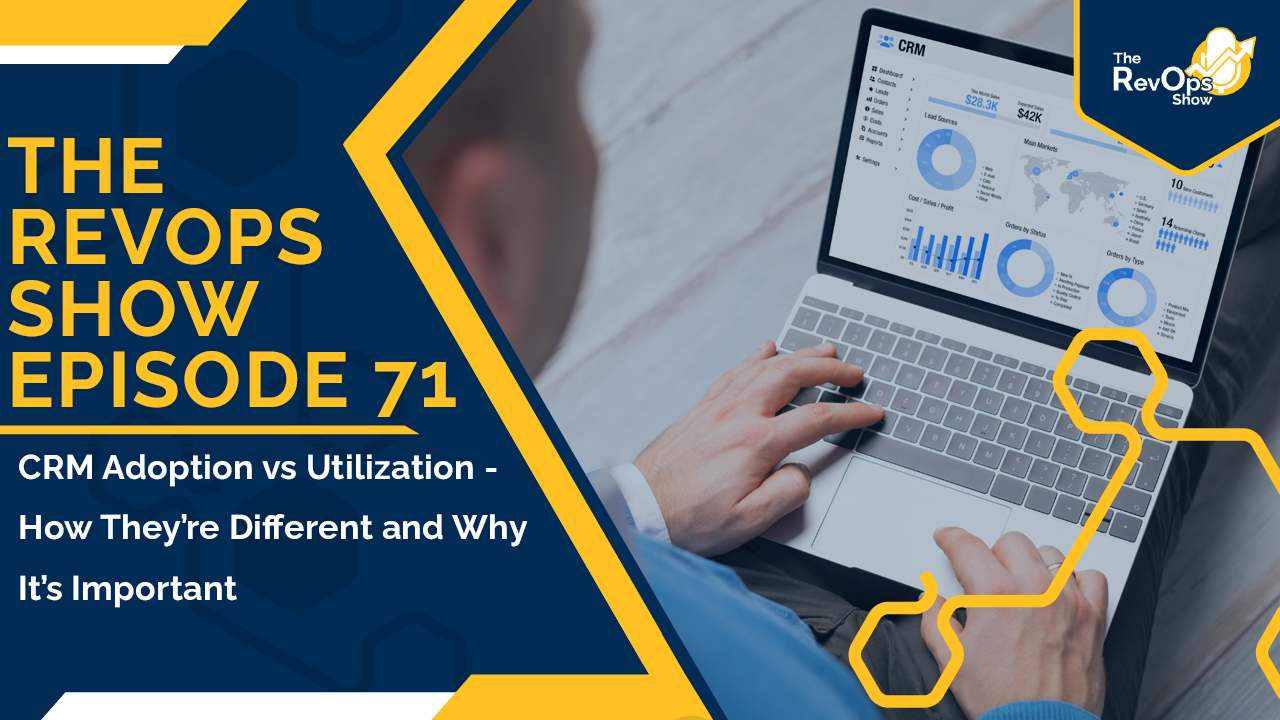Whenever CRM implementation is a topic of discussion, adoption and utilization are usually two words that aren’t far behind. Everyone wants adoption and utilization of their new system, but what people don’t realize is that they use these words interchangeably. When in reality they mean two different things. Adoption refers to the overall acceptance and use of the CRM system by the team and utilization refers to how effectively the team uses the CRM system to achieve their goals.
Audio:
Video:

Additional Resources:
- [Blog] 22 Tips to Increase CRM Adoption
- [RevOps Show] Episode 8: Creating The Adoption Flywheel - Overcoming the Challenges of CRM Adoption
- [RevOps Show] Episode 5: How to Increase CRM Adoption
- [Blog] 9 Ways to Ensure Your Training Boosts CRM Utilization
Show Notes:
Pre-Show Banter: Doug and Jess talk through movies and shows that anyone who works at Lift should see: Shawshank Redemptions, Groundhog Day, Glenn Gary, Glenn Ross, Silicon Valley, House of Lies, Succession, The Good Place. Just to name a few. Also in general, if you haven’t watched these movies/shows, you should.
Adoption and utilization of the CRM are often talked about together, but they are separate concepts. Adoption refers to getting users to use the CRM system, while utilization refers to how well it’s being used. Adoption is the minimum standard, but it doesn’t necessarily mean that the CRM is being used effectively. Poor utilization of CRM can be worse than not having adoption at all because it leads to incorrect data and delays in entering deals. Having accurate data in the CRM is crucial for setting realistic targets and making informed decisions.
Adoption of the CRM is often seen as the main objective, but it should not be the ultimate goal. The real objectives should be:
- Revenue growth
- Growth velocity
- Higher margins
Looking at the CRM through the lens of adoption can lead to a focus on compliance and participation, rather than the goals that truly matter. Not having enough data or having too much data are both problems. The key is to narrow the focus and increase the yield of relevant information.
The main factor that causes users not to adopt is friction caused by extra steps or effort required to use the system for example. There could also be ineffective use of required fields or properties or even a lack of reminders/notifications for missing or incomplete information that causes poor adoption rates. But the thing is with friction you have to keep the inverse friction principle in mind - the ease and effortlessness of a user’s experience has an inverse relationship with the complexity involved in designing the system.
Keep it simple. Keep the implementation and configuration of a system simple to prevent difficulties in using and encouraging adoption. Another thing to keep in mind is that when you’re reviewing the system, think about how it’s being used. If you can find the answers in the system, don’t ask about them. That’s the problem with pipeline reviews - they can be demotivating and unhelpful if they focus solely on judging and criticizing past performance rather than generating value or helping with sales performance.
Implementing a CRM system should be seen as a sales performance initiative focused on driving more sales with less effort, rather than just a technology or CRM initiative.
Likewise, training is often cited as the reason for users not adopting and utilizing CRM system effectively. However, the problem is not that training is ineffective or lacking, but that it focuses solely on teaching users how to use the system. Instead, training should be focused on teaching users the business process and behaviors associated with:
- Effectively managing accounts
- Building account plans
- Managing sales
- Building pipelines
The system should be integrated into the training as a tool or platform to support and streamline these business processes. People do not adopt CRM systems or technology itself. They adopt behaviors and business processes. By teaching the desired behaviors, users will naturally incorporate the CRM into their work.
Adoption can be driven by force, but utilization requires a functioning and effective process. Though driving adoption by force isn’t ideal…
Leaders should use the CRM as a source of information before asking their team for updates. To drive utilization, there should be a reduction in the number of things in the CRM rather than adding more. Likewise, instead of adding more features, focus on extracting and taking away unnecessary elements. Use notifications to remind users to fill in missing information. Limit the number of required fields to increase engagement. Most importantly, treat users as adults and give them autonomy to use the CRM effectively. There is more than one way to use the system, so don’t expect everyone to insert information exactly the same, though any way of getting information into the system should be aligned with the process. It’s important to communicate the “why” behind using the system to help teams understand its importance.
Jess’s Takeaways:
- Communicating the why is a step that frequently gets missed because there’s so much focus on getting to launch of the CRM.
- Adoption is the minimum standard. Utilization is people adoption the system the way it was intended and using the system the way it was intended.
- Utilization is the game you want to play here. It’s show business not tell business for a reason.
Next Steps:
-
Follow Jess, Doug & Lift on socials for updates on the show or other insights:
-
Doug Davidoff: Twitter/X - @dougdavidoff | LinkedIn
-
Jess Cardenas: Twitter/X - @JessDCardenas | LinkedIn
-
Lift Enablement: Twitter/X - @DemandCreator | LinkedIn
-
-
Subscribe to the show on Spotify & Apple Podcasts
-
Check out Let's Play RevOps on Twitch for more commentary on this topic
-
Listen to Episode 72: The Secret to Change Management Success In a Business Environment of Constant Change
